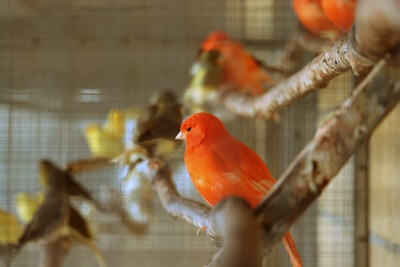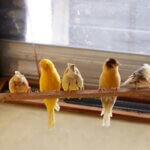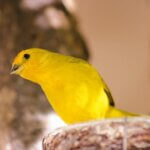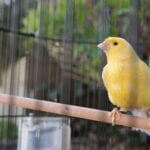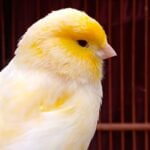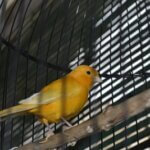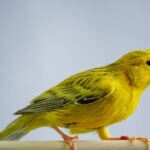Canaries aren’t social animals, so they didn’t evolve the same range of methods for expressing themselves. The bulk of their communication is limited to their complex songs.
With these limitations, it isn’t always easy to figure out how your canary is feeling. After all, a canary won’t learn words or use body language like ours.
So, you may struggle to understand what your canary wants, dislikes, or feels ambivalent about. For example, you may have difficulty understanding when your canary is happy or excited, sad or depressed, annoyed or put off.
That can damper how quickly you remove stressors, reward the canary with something it enjoys or ensure that it grows comfortable with you.
Although canary body language is more subtle, they have cues and gestures they use to communicate without songs. You need to understand how to recognize this unique body language.
How To Understand Canary Body Language
There are basic physical cues that are common among all birds. Puffing up feathers usually means defensiveness, wagging its tail can mean excitement, and pacing can imply boredom.
You’ll know the difference based on the other signs with these gestures. Monitor your canary’s posture and vocalizations as it moves, and consider the surrounding environment.
For example, a puffed-up canary in a cold room is likely attempting to conserve warmth, while a puffed-up canary, when a dog is in the vicinity, may be feeling defensive.
Additionally, a singing canary that flutters around when you enter the room may be drawing your attention, while a silent canary that flutters constantly may be scared.
Here are the main gestures your canary will make throughout its life and what they mean:
Wings
While a canary’s wings are designed for flying, the positioning also creates useful indicators for identifying the bird’s mood. Common cues that a canary might give off with its wings include:
Flapping Wings
If your canary flaps its wings (or flies in place), it’s likely trying to draw your attention. This is common when a canary is in a playful mood and wants to interact with you.
It may also be excited and full of energy, so it flaps its wings quickly to burn this happy feeling. If it’s mealtime, and your canary is looking forward to new treats, it may respond this way.
If your canary only flaps for a second or two, it may be trying to loosen the tension in its wings. This may happen after a nap.
Drooping Wings
It’s not uncommon for young canaries to droop their wings when learning to fold and tuck in their feathers. However, drooping of wings in older canaries is usually indicative of illness or injury.
According to the International Journal of Veterinary Research, salmonellosis is one of the most common diseases that cause wing drooping in birds.
Flipping Wings
Canaries sometimes flip their wings when in pain or feeling angry.
However, this isn’t always the case. If you notice your pet canary flipping its wings, hunching its shoulders, and bobbing its head, it might indicate hunger.
Eyes
Canaries and most other birds can control their irises. Depending on their feelings, they can shrink or rapidly enlarge their pupils. This is known as “pinning,” which birds typically do when they are:
- Excited
- Angry
- Frightened
- Deeply captivated by something in their environment
Because eye pinning has various meanings, you must account for the context and your bird’s posture and environment. This will give you a more accurate interpretation of your canary’s emotions.
A canary investigating an object may have pinned eyes out of interest or curiosity. Meanwhile, a canary that isolates itself in a corner and refuses to sing may have pinned eyes because it’s scared.
An angry canary with pinned eyes will be puffed up and may raise its wings defensively.
An excited canary might flap its wings and chirp while pinning its eyes.
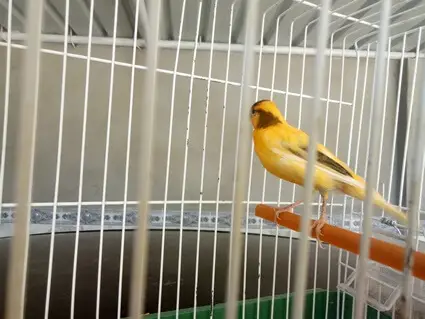
Feathers
The way a canary holds its feathers is telling of its mood. Routine cues that you might observe include:
Ruffling Feathers
Canaries ruffle their feathers when preening because it helps to remove any dirt that might be trapped underneath them. Furthermore, ruffling feathers allows birds to realign poorly laid feathers to return to their normal positions.
If you canary ruffles its feathers often, without preening or tugging at its plumage, it might feel cold or be dealing with pent-up tension. Normally, the feathers will naturally settle back into their original positions.
If your canary’s feathers seem to remain ruffled for prolonged periods, it might be a symptom of illness or anxiety. The canary may comfort itself by puffing up its feathers or making itself appear bigger.
Quivering
Quivering feathers usually happen when a canary feels cold, but it can signify fear. If you notice your canary quivering, check its environment to ensure there are no predators nearby.
Tail
Canaries often use their tails to express their feelings. Cues that canaries make with their tails include:
Wagging
While tail wagging is commonly associated with dogs, canaries wag their tails when they’re happy or excited. This may happen if you approach the canary or walk into the room.
However, tail wagging can also mean your canary is preparing to defecate.
Flipping
Flipping the tail is another body cue that indicates your pet bird is glad to see you, and it can also signify that your pet is contented. Canaries flip their tails when served a treat or playing with their toys.
Bobbing
After physically strenuous exercise, you may find that your canary bobs its tail while breathing heavily. This means it’s trying to catch its breath.
However, if your canary bobs its tail and pants heavily without any activity, it might be due to respiratory distress or infection.
Fanning
Fanning of the tail is a canary’s way of showing dominance and marking territory. You’re more likely to witness this if you have several male canaries in a shared cage.
Beak
A canary’s beak is important for grooming, feeding, and protecting itself against environmental threats. Observing your canary’s beak can give you crucial information about its emotional state:
Grinding
Canaries grind their beaks together as a form of entertainment. The sound is pleasing, and the gesture is comforting, so you may find your canary doing this as it falls asleep at night.
Canaries may also grind their beaks on mineral blocks, perches, and cuttlebones. This is a way to shave them down and maintain a healthy shape. As long as the canary doesn’t appear to do this obsessively, which indicates boredom, it’s a routine part of peak maintenance.
Clicking
Beak clicking has several meanings, depending on the other body cues accompanying it. If your canary clicks its beak while pinning its eyes and assumes an unthreatening posture, it’s probably trying to greet you. On the other hand, if the clicking is rapid and repetitive, it might be a sign of aggression or anger.
Snapping
Canaries will sometimes snap their beaks to defend themselves against attacks.
If your canary is agitated by your presence, it might snap at you when you put your hand inside its cage. It feels threatened when it rapidly opens and shuts its beak in a crouched posture.
Regurgitation
Regurgitation is expelling food or other materials from the mouth, crop, or esophagus. Parent canaries regurgitate ingested food to feed their nestling fledglings. Therefore, if your canary bobs its head and regurgitates food in your presence, it’s trying to feed you or show affection.
However, constant or failed regurgitation can be a sign of illness. It’s most common among birds with crop impaction. This blockage of the crop prevents food from flowing through the digestive tract.
Vocalizations
Canaries are the best-known songbirds, and their ability to create complex melodies. So, it’s natural for them to communicate through vocalizations, with different sounds having different meanings:
Singing
Canaries sing for happiness, entertainment, and to impress others. According to Behavioral and Neural Biology, singing in male canaries is an important factor in mate selection, which usually develops in tandem with their sexual maturation.
Furthermore, males often use songs to carve out territory and keep potential mating rivals at bay.
However, singing is also natural for canaries to express happiness. If your canary is singing more frequently, even though it isn’t yet the breeding season, it’s likely feeling contented.
Screeching
Although canaries can be loud, they rarely scream or screech.
If your canary is suddenly screeching a lot and seems agitated, it might be in pain or frightened. You can reassure it by providing a dark, quiet, calm environment.
To understand your canary’s body language, observe and interact with it. After all, each canary is unique and will give off specific cues under certain circumstances.
It helps to be aware of how your canary normally acts, so you can better understand the meaning behind its actions.

